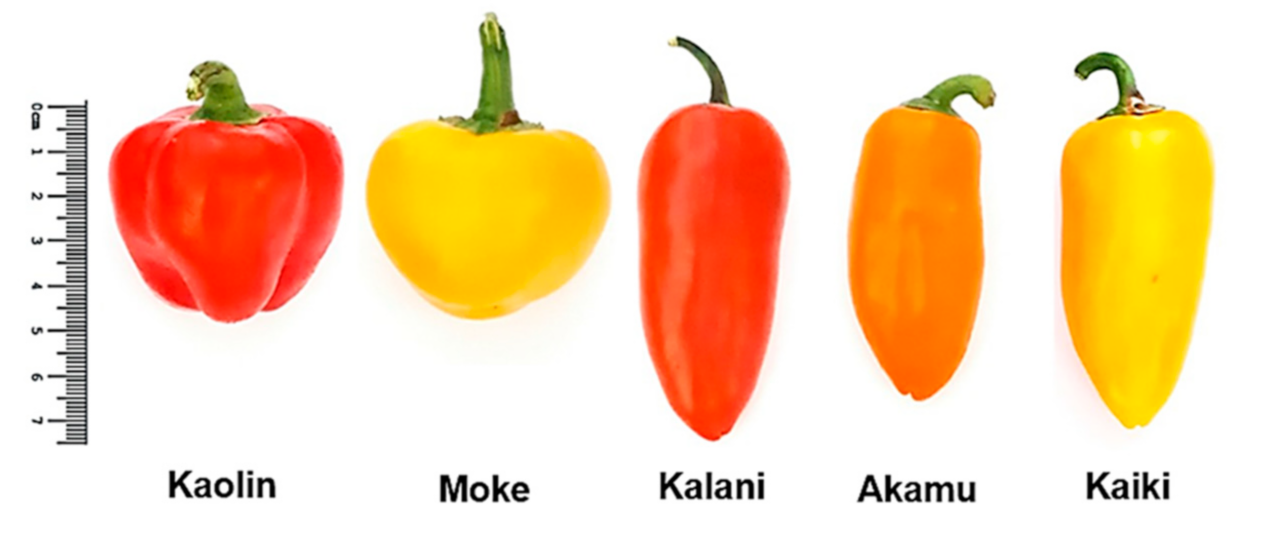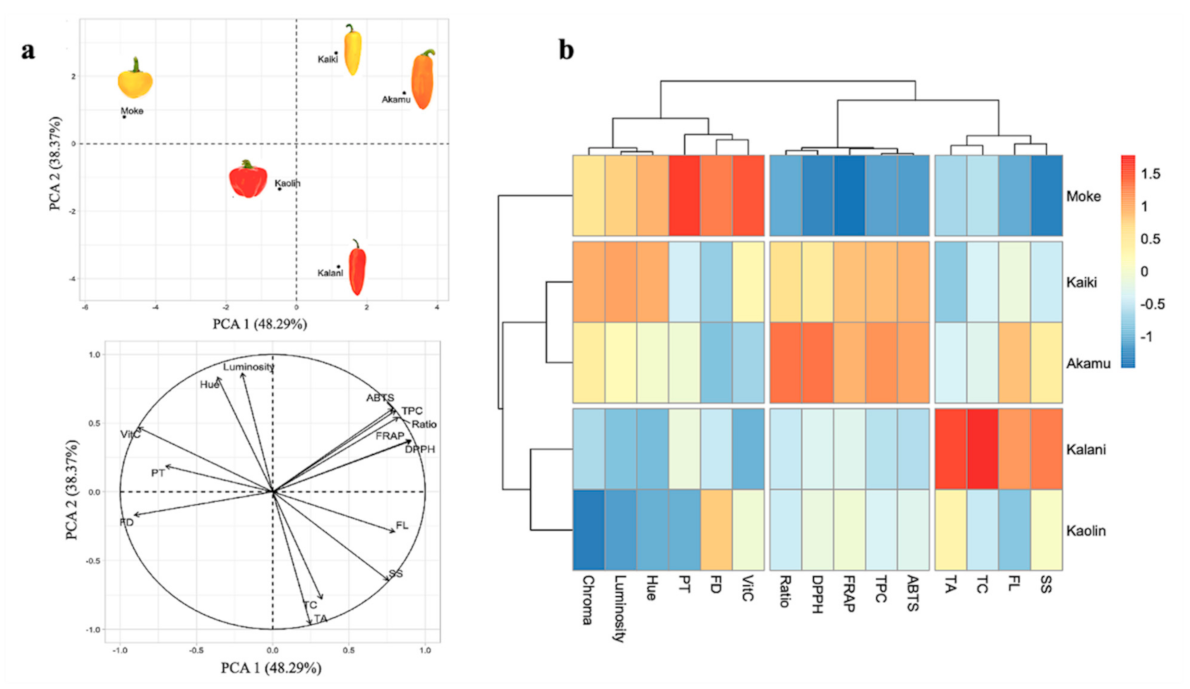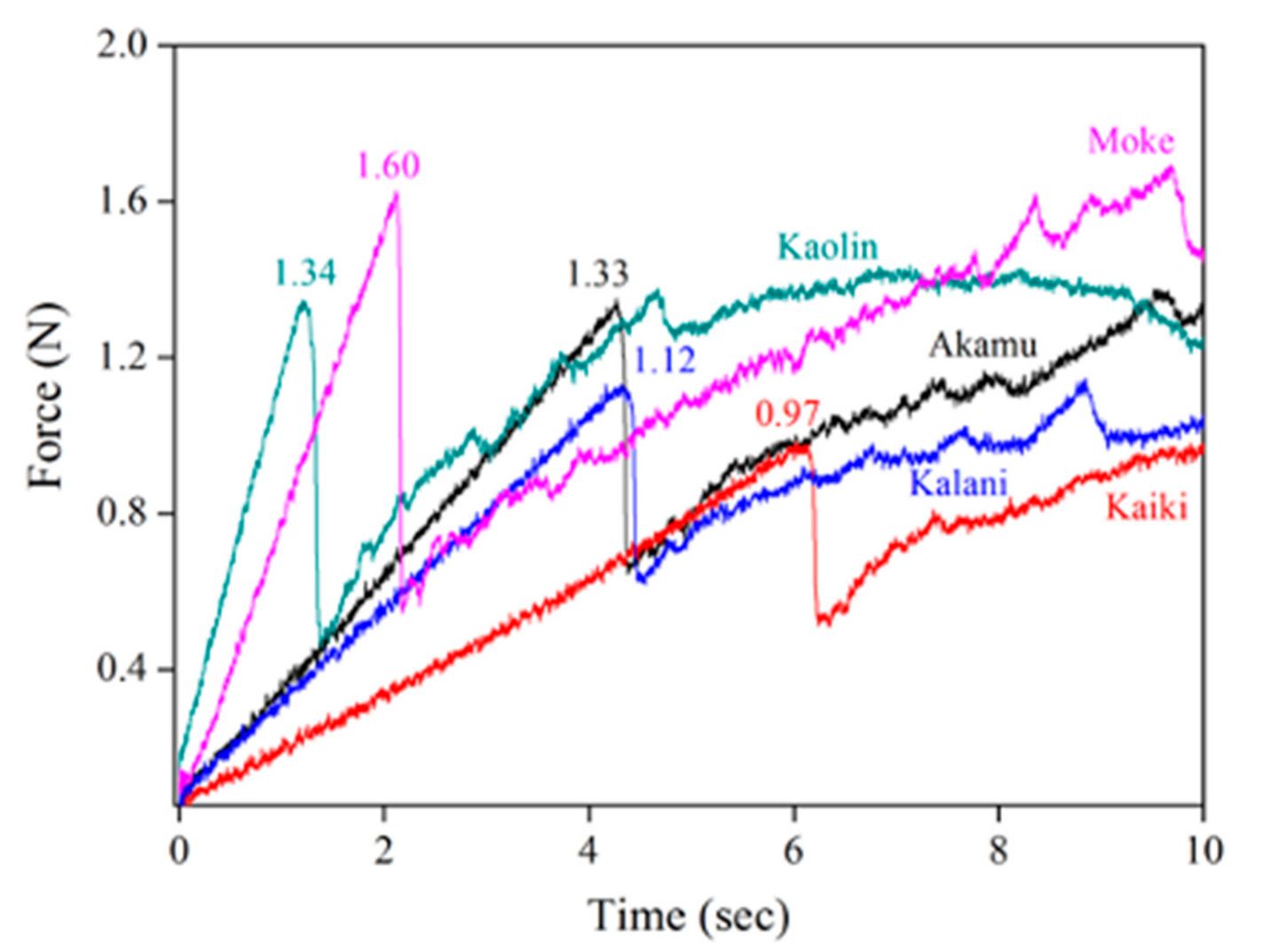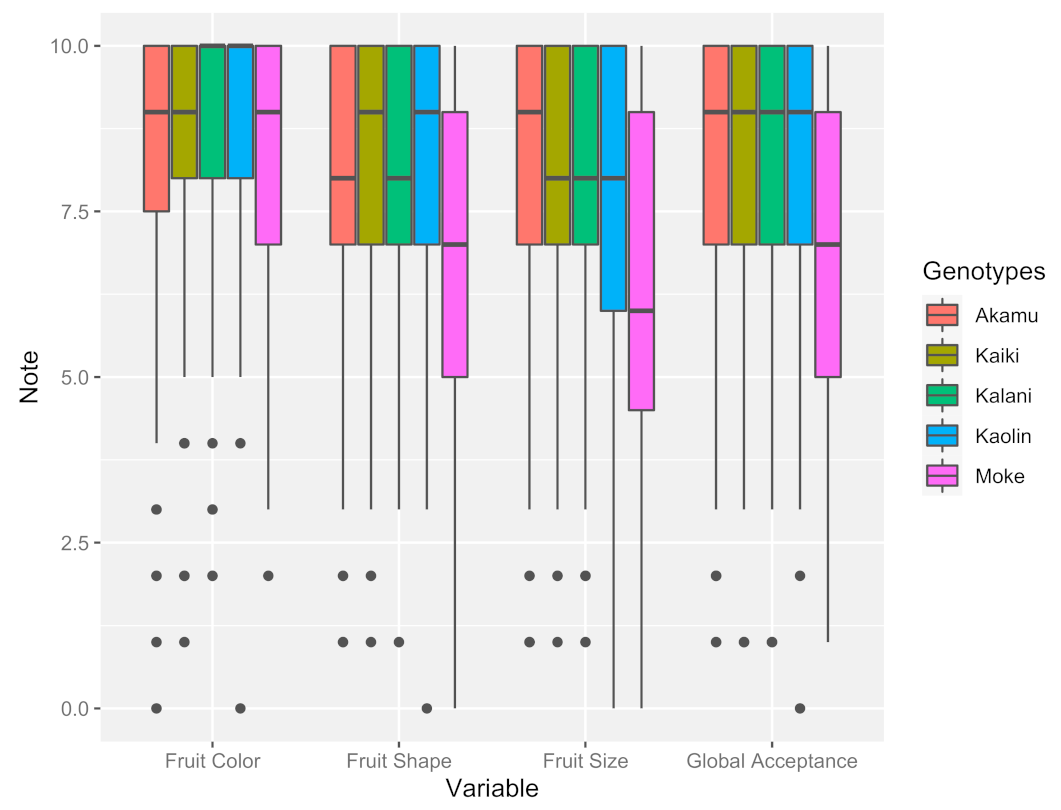Post-Harvest Quality and Sensory Evaluation of Mini Sweet Peppers
Abstract
:1. Introduction
2. Materials and Methods
2.1. Plant Material and Experimental Design
2.2. Physical Characterization
2.3. Biochemical Characterization
2.4. Sensory Evaluation
2.5. Data Analysis
3. Results
3.1. Physical and Biochemical Characterization
3.2. Sensory Evaluation
4. Discussion
5. Conclusions
Author Contributions
Funding
Institutional Review Board Statement
Informed Consent Statement
Conflicts of Interest
References
- World Health Organization. Global Status Report on Alcohol and Health 2014; World Health Organization: Geneva, Switzerland, 2014; pp. 1–392. Available online: https://health-e.org.za/wp-content/uploads/2014/05/Global-status-report-on-alcohol-and-health-2014.pdf (accessed on 12 December 2020).
- Darfour-Oduro, S.A.; Andrade, J.E.; Grigsby-Toussaint, D.S. Review of policies to increase fruit and vegetable consumption and physical activity in 49 low- and middle-income countries. J. Public Health 2019, 41, 119–129. [Google Scholar] [CrossRef]
- World Health Organization. Fruit and Vegetables for Health: Report of the Joint FAO/WHO Workshop on Fruit and Vegetables for Health, 1–3 September 2004, Kobe, Japan; World Health Organization: Geneva, Switzerland, 2004; pp. 1–39. [Google Scholar]
- Noll, P.R.e.S.; Noll, M.; De Abreu, L.C.; Baracat, E.C.; Silveira, E.A.; Sorpreso, I.C.E. Ultra-processed food consumption by Brazilian adolescents in cafeterias and school meals. Sci. Rep. 2019, 1–8. [Google Scholar] [CrossRef] [Green Version]
- Oliveira, M.S.d.S.; Santos, L.A.d.S. Dietary guidelines for Brazilian population: An analysis from the cultural and social dimensions of food. Ciência Saúde Coletiva 2020, 25, 2519–2528. [Google Scholar] [CrossRef]
- Hartmann, Y.; Botelho, R.B.A.; Akutsu, R.D.C.C.d.A.; Zandonadi, R.P. Consumption of Fruits and Vegetables by Low-Income Brazilian Undergraduate Students: A Cross-Sectional Study. Nutrients 2018, 10, 1121. [Google Scholar] [CrossRef] [Green Version]
- Schreinemachers, P.; Simmons, E.B.; Wopereis, M.C.S. Tapping the economic and nutritional power of vegetables. Glob. Food Secur. 2018, 16, 36–45. [Google Scholar] [CrossRef]
- de Souza, J.L.; Guarçoni, R.C.; Favarato, L.F.; Angeletti, M.d.P.; Bahiense, D.V.; de Souza Ribeiro, C. Sprout density for the production of organic mini-cabbage from mother plant regrowth. Ciência Rural 2017, 47, 1–7. [Google Scholar]
- Zagati, F.; da Silva, A.R.; Deleo, J.P.B.; Sabio, R.P. Mini E “Baby” Frutas E Hortaliças; CEAPEA-USP: São Paulo, Brazil, 2013; pp. 8–20. [Google Scholar]
- Lemos, M.F.; Lemos, M.F.; Pacheco, H.P.; Scherer, R. Monitoring of organophosphorous pesticide resdues in samples of banana, papaya, and bell pepper. Química Nova 2015, 38, 268–273. [Google Scholar] [CrossRef]
- Mendes, R.T.; Resende, R.C.; Pereira, M.A.M.; Bento, R.U.; da Silva, R.C.D.; Cruz, S.J.S.; Pelá, A. Foliar application of urea and bell pepper amino acids. Afr. J. Agric. Res. 2016, 11, 1674–1678. [Google Scholar]
- Phillips, K.M.; Ruggio, D.M.; Ashraf-Khorassani, M.; Haytowitz, D.B. Difference in folate content of green and red sweet peppers (Capsicum annuum) determined by liquid chromatography− mass spectrometry. J. Agric. Food Chem. 2006, 54, 9998–10002. [Google Scholar] [CrossRef]
- Wahyuni, Y.; Ballester, A.-R.; Sudarmonowati, E.; Bino, R.J.; Bovy, A.G. Metabolite biodiversity in pepper (Capsicum) fruits of thirty-two diverse accessions: Variation in health-related compounds and implications for breeding. Phytochemistry 2011, 72, 1358–1370. [Google Scholar] [CrossRef]
- Cuvelier, M.E.; Berset, C. 4A Standard Calibration Techniques. Microflown E-Book 1995, 28, 25–30. [Google Scholar] [CrossRef]
- Ferreira, E.B.; Cavalcanti, P.P.; Nogueira, D.A. ExpDes: An R Package for ANOVA and Experimental Designs. Appl. Math. 2014, 05, 2952–2958. [Google Scholar] [CrossRef] [Green Version]
- Husson, A.F.; Josse, J.; Le, S.; Mazet, J.; Husson, M.F. Package ‘FactoMineR’. 2020. Available online: https://cran.rediris.es/web/packages/FactoMineR/FactoMineR.pdf (accessed on 15 April 2021).
- Gómez-Rubio, V. ggplot2—Elegant Graphics for Data Analysis (2nd Edition). J. Stat. Softw. 2017, 77, 2–5. [Google Scholar] [CrossRef] [Green Version]
- Kolde, R. Pheatmap: Pretty Heatmaps; R Package Version 1.0.8; R Package: Madison, WI, USA, 2015; pp. 1–7. [Google Scholar]
- do Rêgo, E.R.; do Rêgo, M.M.; de Matos, I.W.F.; Barbosa, L.A. Morphological and chemical characterization of fruits of Capsicum spp. accessions. Hortic. Bras. 2011, 29, 364–371. [Google Scholar] [CrossRef] [Green Version]
- Zimmer, A.R.; Leonardi, B.; Miron, D.; Schapoval, E.; de Oliveira, J.R.; Gosmann, G. Antioxidant and anti-inflammatory properties of Capsicum baccatum: From traditional use to scientific approach. J. Ethnopharmacol. 2012, 139, 228–233. [Google Scholar] [CrossRef] [Green Version]
- Kyriacou, M.C.; Rouphael, Y. Towards a new definition of quality for fresh fruits and vegetables. Sci. Hortic. 2018, 234, 463–469. [Google Scholar] [CrossRef]
- R Core Team. R: A language and environment for statistical computing. R Core Team: Vienna, Austria, 2013. [Google Scholar]
- Maynard, E.; Calsoyas, I.S. Sugar-Enhanced and Synergistic Sweet Corn Cultivar Evaluation Sugar-Enhanced and Synergistic Sweet Corn Cultivar Evaluation for Northern Indiana, 2015; Purdue University: West Lafayette, IN, USA, 2016. [Google Scholar]
- Corrêa, C.V.; De Mendonça, V.Z.; Gouveia, A.M.d.S.; Carpanetti, M.G.; Tavares, A.E.B.; Lanna, N.d.B.L.; Evangelista, R.M.; Cardoso, A.I.I. Physicochemical and biochemical traits of sweet pepper hybrids as a function of harvest times. Food Chem. 2018, 257, 265–270. [Google Scholar] [CrossRef]
- Rinaldi, M.M.; Sandri, D.; Ribeiro, O.; Garcia, A. Características físico-químicas e nutricionais de pimentão produzido em campo e hidroponia. Food Sci. Technol. 2008, 28, 558–563. [Google Scholar] [CrossRef] [Green Version]
- Hernández-Pérez, T.; Gómez-García, M.R.; Valverde, M.E.; Paredes-López, O. Capsicum annuum (hot pepper): An ancient Latin-American crop with outstanding bioactive compounds and nutraceutical potential. A review. Compr. Rev. Food Sci. Food Saf. 2020, 2972–2993. [Google Scholar] [CrossRef] [PubMed]
- Rao, A.V.; Rao, L.G. Carotenoids and human health. Pharmacol. Res. 2007, 55, 207–216. [Google Scholar] [CrossRef]
- Fratianni, F.; Acierno, A.; Cozzolino, A.; Spigno, P.; Riccardi, R.; Raimo, F.; Pane, C.; Zaccardelli, M.; Lombardo, V.T.; Tucci, M.; et al. Biochemical Characterization of Traditional Varieties of Sweet Pepper (Capsicum annuum L.) of the Campania Region, Southern Italy. Antioxidants 2020, 9, 556. [Google Scholar] [CrossRef] [PubMed]
- Hassan, A.; Muhammad Rafiq, M.I.; Zainal Ariffin, M.I. Improving Thermal and Mechanical Properties of Injection Moulded Kenaf Fibre-reinforced Polyhydroxy- butyrate Composites through Fibre Surface Treatment. BioResources 2019, 14, 3101–3116. [Google Scholar]
- Mennella, G.; D’Alessandro, A.; Francese, G.; Fontanella, D.; Parisi, M.; Tripodi, P. Occurrence of variable levels of health-promoting fruit compounds in horn-shaped Italian sweet pepper varieties assessed by a comprehensive approach. J. Sci. Food Agric. 2018. [Google Scholar] [CrossRef]
- Nankar, A.N.; Todorova, V.; Tringovska, I.; Pasev, G.; Radeva-Ivanova, V.; Ivanova, V.; Kostova, D. A step towards Balkan Capsicum annuum L. core collection: Phenotypic and biochemical characterization of 180 accessions for agronomic, fruit quality, and virus resistance traits. PLoS ONE 2020, 15, e0237741. [Google Scholar] [CrossRef]
- Available online: http://www.fda.gov/Food/GuidanceRegulation/GuidanceDocumentsRegulatoryInformation/LabelingNutrition/ucm064928.html (accessed on 12 December 2020).
- Rodriguez-Amaya, D.B. A Guide to Analysis In; ILSI Press: Washington, DC, USA, 2001; ISBN 1578810728. [Google Scholar]
- Huang, D. Dietary Antioxidants and Health Promotion. Antioxidants 2018, 7, 9. [Google Scholar] [CrossRef] [Green Version]




| Traits a | Genotypes | CV% b | ||||
|---|---|---|---|---|---|---|
| Kalani | Kaiki | Akamu | Moke | Kaolin | ||
| Physical | ||||||
| FL | 82.40 a | 60.63 b | 77.73 a | 44.07 c | 48.20 bc | 9.5 |
| FD | 27.57 bc | 25.87 bc | 25.23 c | 38.03 a | 35.23 ab | 11.9 |
| PT | 3.20 b | 3.00 b | 3.23 b | 4.37 a | 2.60 b | 10.0 |
| Biochemical | ||||||
| SS | 9.97 a | 7.27 bc | 8.70 ab | 5.87 c | 8.10 abc | 12.1 |
| TA | 0.46 a | 0.29 c | 0.32 bc | 0.30 c | 0.37 b | 5.9 |
| Ratio | 21.40 c | 24.76 b | 26.84 a | 19.73 c | 21.55 c | 10.1 |
| TC | 10,323.08 a | 2374.3 b | 2758.9 b | 1707.7 b | 2066.7 b | 8.5 |
| VITC | 183.8 b | 213.2 ab | 191.2 b | 242.6 a | 205.9 ab | 8.2 |
| TPC | 677.2 c | 802.2 ab | 825.5 a | 630.5 bc | 695.5 abc | 7.4 |
| DPPH | 1389.3 bc | 1449.3 ab | 1513.5 a | 1315.3 c | 1400.5 bc | 2.8 |
| ABTS | 1489.6 bc | 1633.9 ab | 1642.0 a | 1443.1 c | 1520.8 abc | 3.5 |
| FRAP | 7597.6 b | 8059.4 a | 8097.2 a | 7127.41 c | 7692.1 ab | 2.2 |
| Colors | ||||||
| Luminosity | 33.13 c | 51.60 a | 43.37 b | 48.63 a | 30.47 c | 5.9 |
| Chroma | 31.37 b | 50.57 a | 44.33 a | 45.83. a | 22.40 c | 8.2 |
| Hue | 30.63 c | 72.33 a | 50.77 b | 71.87 a | 28.80 c | 6.9 |
| Sensory | ||||||
| Size | 8.03 a | 8.05 a | 8.03 a | 6.34 b | 7.60 a | 23.93 |
| Shape | 8.05 a | 8.22 a | 8.12 a | 6.64 b | 8.17 a | 25.27 |
| Color | 8.74 ab | 8.59 ab | 8.30 b | 8.27 b | 9.05 a | 20.33 |
| Global acceptance | 8.10 a | 8.02 a | 7.89 a | 6.70 b | 7.94 a | 25.09 |
Publisher’s Note: MDPI stays neutral with regard to jurisdictional claims in published maps and institutional affiliations. |
© 2021 by the authors. Licensee MDPI, Basel, Switzerland. This article is an open access article distributed under the terms and conditions of the Creative Commons Attribution (CC BY) license (https://creativecommons.org/licenses/by/4.0/).
Share and Cite
Giacomin, R.M.; Constantino, L.V.; Nogueira, A.F.; Ruzza, M.B.C.; Morelli, A.M.; Branco, K.S.; Rossetto, L.M.; Zeffa, D.M.; Gonçalves, L.S.A. Post-Harvest Quality and Sensory Evaluation of Mini Sweet Peppers. Horticulturae 2021, 7, 287. https://doi.org/10.3390/horticulturae7090287
Giacomin RM, Constantino LV, Nogueira AF, Ruzza MBC, Morelli AM, Branco KS, Rossetto LM, Zeffa DM, Gonçalves LSA. Post-Harvest Quality and Sensory Evaluation of Mini Sweet Peppers. Horticulturae. 2021; 7(9):287. https://doi.org/10.3390/horticulturae7090287
Chicago/Turabian StyleGiacomin, Renata Mussoi, Leonel Vinícius Constantino, Alison Fernando Nogueira, Maria Beatriz Cadato Ruzza, Ariele Maria Morelli, Kelvin Shinohata Branco, Lais Martins Rossetto, Douglas Mariani Zeffa, and Leandro Simões Azeredo Gonçalves. 2021. "Post-Harvest Quality and Sensory Evaluation of Mini Sweet Peppers" Horticulturae 7, no. 9: 287. https://doi.org/10.3390/horticulturae7090287
APA StyleGiacomin, R. M., Constantino, L. V., Nogueira, A. F., Ruzza, M. B. C., Morelli, A. M., Branco, K. S., Rossetto, L. M., Zeffa, D. M., & Gonçalves, L. S. A. (2021). Post-Harvest Quality and Sensory Evaluation of Mini Sweet Peppers. Horticulturae, 7(9), 287. https://doi.org/10.3390/horticulturae7090287







